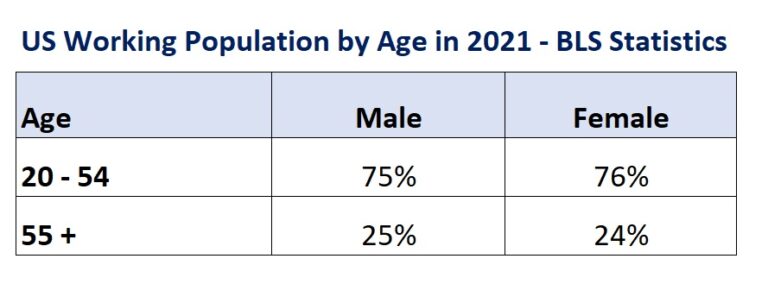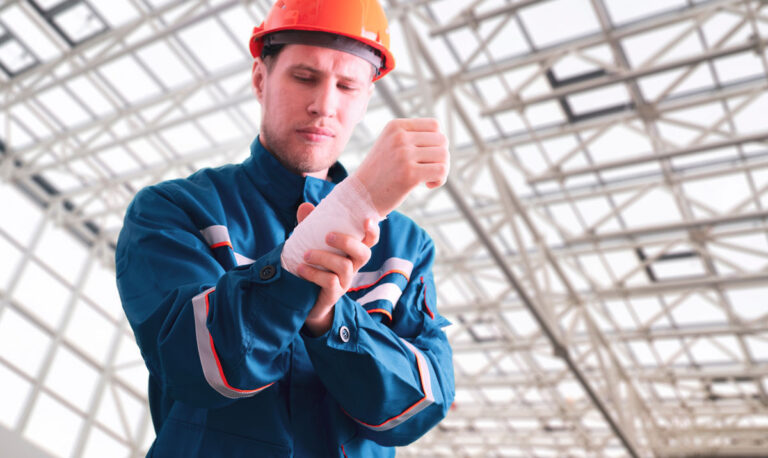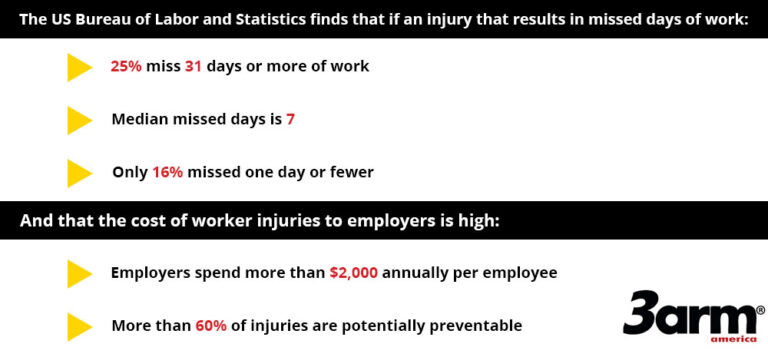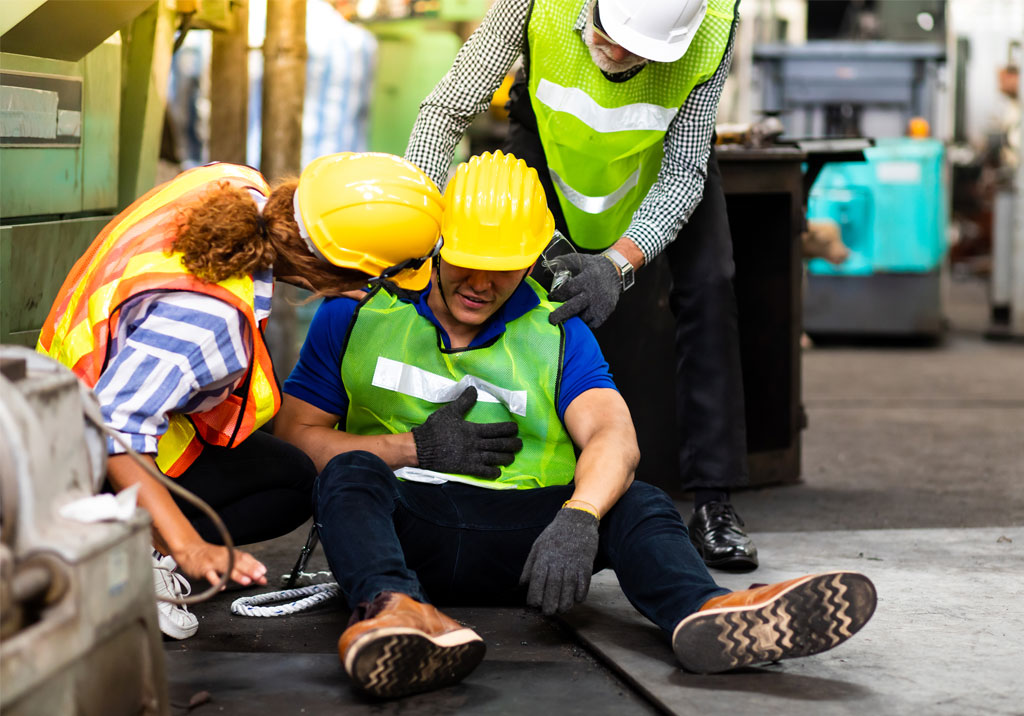If you’re a production manager in a high-volume manufacturing facility, the last thing you want to hear from your assembly supervisor is this:
“I have bad news. The precision assembler torqued her wrist yesterday and she’s going to be out for 6 weeks of physical therapy. Plus, one of my material handlers dropped a heavy part on his hand this morning and broke a couple of fingers, so he’s out for a while too.”
With the shortage of qualified, reliable labor and increasing production rates, you don’t want to hear that one of your team will be missing days of work. It’s more important than ever to ensure your current staff remain healthy and on the job.
Working in a manufacturing setting without ergonomic safeguards leaves workers prone to injury. Common ergonomic and job risk factors include:
- Repetitive motion
- Over-exertion
- Over-reach
- Reactive torque
- Postural strain
- Vibrations
- Trauma (struck, cut or caught by equipment)
Many of these cause musculoskeletal disorders (MSDs), injuries and disorders that affect the human body’s movement or musculoskeletal system (muscles, tendons, ligaments, nerves, discs, blood vessels, etc.).

The World Health Organization states that MSD conditions are the leading contributor to disability worldwide, significantly limit mobility and dexterity, and lead to early retirement from work and lower levels of well-being.
They also state that because of population increases and aging, the number of people with musculoskeletal conditions and associated disabilities is rapidly increasing and projected to continue increasing in the next decades.
In fact, the average age of an employee in the US workforce today is 42, and a quarter of the workforce is 55 or over – making health and safety a big concern for employers.

>> Read more about the role of ergonomics in attracting and retaining manufacturing employees
Types of injuries in manufacturing
There are many types of injuries that can befall an employee in a manufacturing setting, from strains and sprains to cuts and lacerations. According to the U.S. Bureau of Labor Statistics (BLS), manufacturing accounted for 15 percent of all private industry nonfatal injuries and illnesses in 2019 and the most common types of injuries were:
- Sprains, strains and tears
- Soreness and pain
- Cuts, lacerations and punctures
- Bruises and contusions
- Fractures
>> How Much is Too Much? What Are Safe Limits of Force and Exertion for Operators

Examples of sprain, strain or tear injuries include:
- Muscle strain – An injury to a muscle or to the band of tissue that attaches a muscle to a bone. This can be caused by overexertion, repetitive motion, postural strain and more.
- Ligament sprain – A stretching or tearing of ligaments, the tough bands of fibrous tissue that connect two bones together in your joints. A ligament tear is a sudden and painful injury caused by activities like lifting heavy objects, which causes a sprain and can take weeks to heal.
- Rotator cuff tendonitis or tear – A sprain or tear in the muscles or tendons surrounding the shoulder joint. This causes pain in the shoulder, especially on movement. This injury can require surgery and take months of recovery and extensive physical therapy to heal correctly.
- Degenerative disk disease – A result of the cushioning in the spine beginning to wear away. The condition is most common in older adults. After age 40, most people experience some spinal degeneration. It can also be caused by working a physically demanding job or by acute injury.
- Herniated disk – A problem with one of the disks that sit between the vertebrae in the spine. People with physically demanding jobs have a greater risk of back problems. Repetitive lifting, pulling, pushing, bending sideways and twisting can increase the risk of a herniated disk.

Examples of injuries that cause soreness or pain include:
- Epicondylitis is the inflammation of the tendons surrounding the elbow, typically due to overuse and repetitive motions of the forearm.
- Thoracic outlet compression Disorders result in pain in the shoulder and neck due to compression of nerves or blood vessels below the neck.
- Carpal tunnel syndrome is caused by pressure on the median nerve in the wrist.
- Tendinitis is inflammation or irritation of a tendon, the thick fibrous cords that attach muscle to bone.
- Tension neck syndrome (TNS) can occur when the neck and upper shoulders are held in a fixed, awkward position for long periods of time.
- Radial tunnel syndrome is a set of symptoms that include fatigue or a dull, aching pain at the top of the forearm with use.
- Digital neuritis is an inflammation of a nerve or nervous system of the hands or feet and can be caused by acute or chronic local trauma or pressure.
- Mechanical back pain is a common disability often associated with facet joint syndrome. Facet pain is usually heightened with activities that cause excess movement of the spine such as rotating or bending the spine backward, twisting and lifting.
- Hand–arm vibration syndrome (sometimes abbreviated to HAVS) causes changes in the sensation of the fingers which can lead to permanent numbness of fingers, muscle weakness and, in some cases, bouts of white finger. It is caused by working with vibrating tools.
Are ergonomic solutions worth the investment?

Injuries on the job cost businesses and their employees a significant amount of money. An investment in an ergonomic lift assist device by 3arm may seem hefty – until you calculate the cost of just one injury to an employee.
For example, due to a repetitive motion injury, the OSHA SafetyPays program estimated cost calculator shows that one carpal tunnel diagnosis can result in almost $66,000 in direct and indirect costs, such as increased insurance costs and missed days of work.
For a fracture, that figure jumps to more than $115,000.
Seeing these figures means that an investment in ergonomic solutions to protect your employees is a no-brainer and will pay for itself many times over.
>> Lean more about the cost of injuries in manufacturing
The Washington State Department of Labor and Industries found out that an investment in ergonomics is well worth the investment. After reviewing 250 ergonomics case studies, they found investing in a good ergonomic solution provided significant positive impact on cost savings, productivity and product quality.
EHS Today reports that “with the costs of injuries steadily rising, society is embracing the belief that corporate leaders and their boards of directors have more than a moral and ethical reason to protect workers; they have a fiduciary duty to do so.” They argue that the ROI exceeds the cost of the technology to improve the health and safety of your employees.

Ergonomic solutions by 3arm have proved to significantly reduce the amount of force needed to do many tasks in manufacturing, creating a safer and healthier workplace. 3arm lift assist and pick-and-place arms will help you cut operational costs and retain valuable employees with tribal knowledge plus create a reputation that attracts high quality recruits.
For more information, contact us at 3armAmerica to see how we can help design an ergonomic solution for your needs.

